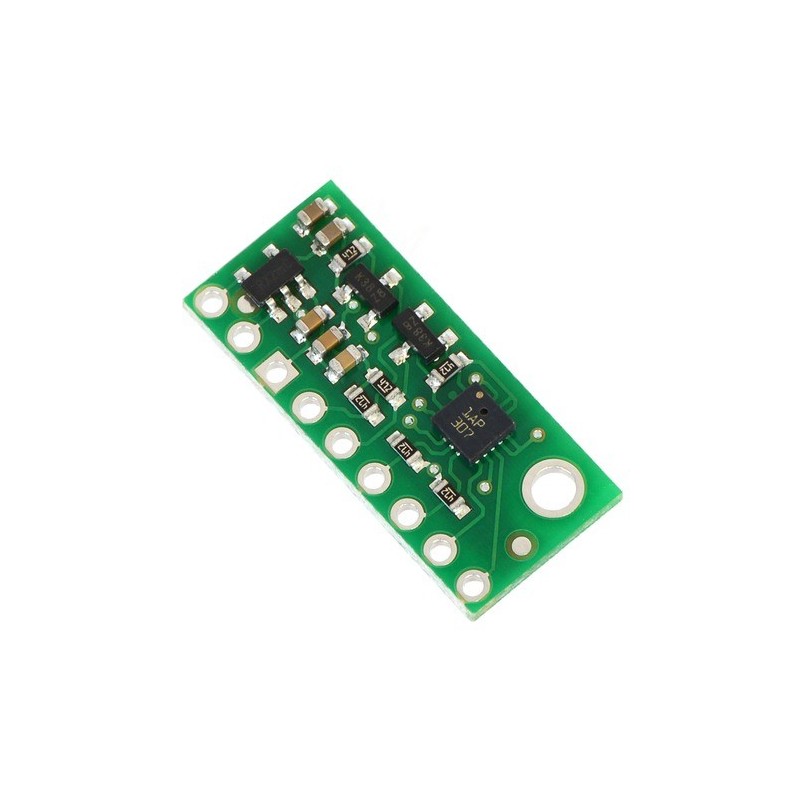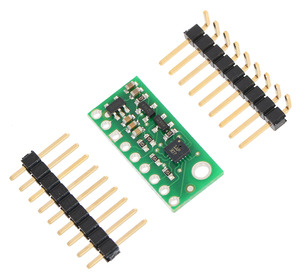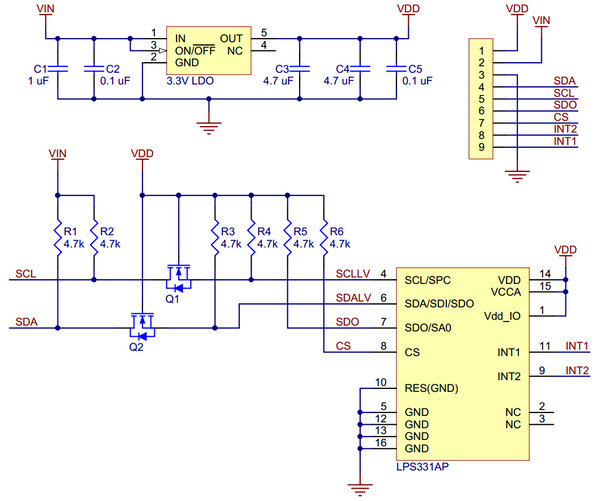



18,25 zł Netto
Moduł czujnika ciśnienia / wysokości z sensorem LPS331AP (zakres pomiarowy od 26 kPa do 126 kPa z dokładnością ± 0.2 kPa). Komunikacja z modułem odbywa się poprzez magistralę SPI lub I2C
LPS331AP Pressure/Altitude Sensor Carrier with Voltage Regulator
This carrier for ST’s LPS331AP digital barometer measures pressures from 260 mbar to 1260 mbar (26 kPa to 126 kPa) with absolute accuracy down to ±2 mbar (0.2 kPa) and typical RMS noise of 0.02 mbar (0.002 kPa) in high-resolution mode. These pressures can easily be converted to altitudes. The board has a 3.3 V linear regulator and integrated level shifters that allow it to work over an input voltage range of 2.5 V to 5.5 V, and the 0.1" pin spacing makes it easy to use with standard solderless breadboards and 0.1" perfboards. The sensor offers I2C and SPI interfaces.
 |
This board is a compact (0.4" A— 0.9") carrier for ST’s LPS331AP MEMS absolute pressure sensor, or barometer; we therefore recommend careful reading of the LPS331AP datasheet (453k pdf) before using this product. The LPS331 is a great IC, but its small, leadless, LGA package makes it difficult for the typical student or hobbyist to use. It also operates at voltages below 3.6 V, which can make interfacing difficult for microcontrollers operating at 5 V. This carrier board addresses these issues by incorporating additional electronics, including a 3.3 V voltage regulator and level-shifting circuits, while keeping the overall size as compact as possible. The board ships fully populated with its SMD components, including the LPS331AP, as shown in the product picture.
The LPS331 features embedded temperature compensation and has many configurable options, including selectable resolutions, a choice of output data rates, and two programmable external interrupt signals. Its pressure output has an absolute accuracy as low as ±2 mbar (0.2 kPa), with RMS noise of 0.02 mbar (0.002 kPa) in the highest-resolution mode. Pressure and temperature sensor data are available through a digital interface, which can be configured to operate in either I2C or SPI mode, and can be used for altimetry. (See the Sample Code section below for an Arduino library that can be used to turn this sensor into an altimeter).
The carrier board includes a low-dropout linear voltage regulator that provides the 3.3 V required by the LPS331, which allows the sensor to be powered from a 2.5 V to 5.5 V supply. The regulator output is available on the VDD pin and can supply almost 150 mA to external devices. The breakout board also includes a circuit that shifts the I2C/SPI clock and data in lines to the same logic voltage level as the supplied VIN, making it simple to interface the board with 5 V systems, and the board’s 0.1" pin spacing makes it easy to use with standard solderless breadboards and 0.1" perfboards.
For sensor fusion applications, AltIMU-10 inertial measurement unit combines the LPS331AP with an L3GD20 3-axis gyro and an LSM303DLHC 3-axis accelerometer and 3-axis magnetometer on a single board, providing ten independent readings that can be used to calculate an absolute orientation and altitude.
A 1A—9 strip of 0.1" header pins and a 1A—9 strip of 0.1" right-angle header pins are included, as shown in the picture below. You can solder the header strip of your choice to the board for use with custom cables or solderless breadboards, or you can solder wires directly to the board itself for more compact installations.
 |
The board has one mounting hole that works with #2 and M2 screws (not included).
Regardless of the interface being used to communicate with the LPS331AP, its VIN pin should be connected to a 2.5 V to 5.5 V source, and GND should be connected to 0 volts. (Alternatively, if you are using the sensor with a 3.3 V system, you can leave VIN disconnected and bypass the built-in regulator by connecting 3.3 V directly to VDD.)
A minimum of two logic connections are necessary to use the LPS331 in I2C mode (this is the default mode): SCL and SDA. These should be connected to an I2C bus operating at the same logic level as VIN.
To use the LPS331 in the default SPI mode, four logic connections are required: SPC, SDI, SDO, and CS. These should be connected to an SPI bus operating at the same logic level as VIN. The SPI interface operates in 4-wire mode by default, with SDI and SDO on separate pins, but it can be configured to use 3-wire mode so that SDO shares a pin with SDI.
|
|
| PIN | Description |
|---|---|
| VDD | Regulated 3.3 V output. Almost 150 mA is available to power external components. (If you want to bypass the internal regulator, you can instead use this pin as a 3.3 V input with VIN disconnected.) |
| VIN | This is the main 2.5 V to 5.5 V power supply connection. The SCL/SPC and SDA/SDI level shifters pull the I2C and SPI bus high bits up to this level. |
| GND | The ground (0 V) connection for your power supply. Your I2C or SPI control source must also share a common ground with this board. |
| SDA/SDI/SDO | Level-shifted I2C data line and SPI data in line (also doubles as SDO in 3-wire mode): HIGH is VIN, LOW is 0 V |
| SCL/SPC | Level-shifted I2C/SPI clock line: HIGH is VIN, LOW is 0 V |
| SDO/SA0 | SPI data out line in 4-wire mode: HIGH is VDD, LOW is 0 V. This output is not level-shifted. Also used as an input to determine I2C slave address (see below). |
| CS | SPI enable (chip select). Pulled up to VDD to enable I2C communication by default; drive low to begin SPI communication. |
| INT2 | Programmable interrupt, a 3.3-V-logic-level output. This output is not level-shifted. |
| INT1 | Programmable interrupt, a 3.3-V-logic-level output. This output is not level-shifted. |
 |
The above schematic shows the additional components the carrier board incorporates to make the LPS331AP easier to use, including the voltage regulator that allows the board to be powered from a 2.5 V to 5.5 V supply and the level-shifter circuit that allows for I2C and SPI communication at the same logic voltage level as VIN. This schematic is also available as a downloadable PDF (156k pdf).
With the CS pin in its default state (pulled up to VDD), the LPS331AP can be configured and its pressure reading can be queried through the I2C bus. Level shifters on the I2C clock (SCL) and data (SDA) lines enable I2C communication with microcontrollers operating at the same voltage as VIN (2.5 V to 5.5 V). A detailed explanation of the I2C interface on the LPS331 can be found in its datasheet (453k pdf), and more detailed information about I2C in general can be found in NXP’s I2C-bus specification (371k pdf).
In I2C mode, the sensor’s 7-bit slave address has its least significant bit (LSb) determined by the voltage on the SA0 pin. The carrier board pulls SA0 to VDD through a 4.7 kΩ resistor, making the LSb 1 and setting the slave address to 1011101b by default. If the pressure sensor’s selected slave address happens to conflict with some other device on your I2C bus, you can drive SA0 low to set the LSb to 0.
The I2C interface on the LPS331 is compliant with the I2C fast mode (400 kHz) standard. In our tests of the board, we were able to communicate with the chip at clock frequencies up to 400 kHz; higher frequencies might work but were not tested. It is missing 50 ns spike suppression on the clock and data lines, and additional pull-ups on the clock and data lines might also be necessary to achieve compliant signal timing characteristics.
To communicate with the LPS331AP in SPI mode, the CS pin (which the board pulls to VDD through a 4.7 kΩ resistor) must be driven low before the start of an SPI command and allowed to return high after the end of the command. Level shifters on the SPI clock (SPC) and data in (SDI) lines enable SPI communication with microcontrollers operating at the same voltage as VIN (2.5 V to 5.5 V).
In the default 4-wire mode, the pressure sensor transmits data to the SPI master on a dedicated data out (SDO) line that is not level-shifted. If the SPI interface is configured to use 3-wire mode instead, the SDI line doubles as SDO and is driven by the LPS331 when it transmits data to the master. A detailed explanation of the SPI interface on the LPS331 can be found in its datasheet (453k pdf).
We have written a basic Arduino library for the LPS331 that makes it easy to interface this sensor with an Arduino. The library makes it simple to configure the LPS331 and read the raw pressure data through I2C, and it provides functions for calculating altitude based on the measured pressure for those looking to use this sensor as an altimeter.
The datasheet provides all the information you need to use this sensor, but picking out the important details can take some time. Here are some pointers for communicating with and configuring the LPS331AP that we hope will get you up and running a little bit faster:
 |
ACS711EX Current Sensor Carrier -31A to +31A |
 |
AltIMU-10 Gyro, Accelerometer, Compass, and Altimeter (L3GD20, LSM303DLHC, and LPS331AP Carrier) |
 |
ACS711EX Current Sensor Carrier -15.5A to +15.5A |
Cechy
Producent BTC Korporacja sp. z o. o. Lwowska 5 05-120 Legionowo Polska sprzedaz@kamami.pl 22 767 36 20
Osoba odpowiedzialna BTC Korporacja sp. z o. o. Lwowska 5 05-120 Legionowo Polska sprzedaz@kamami.pl 22 767 36 20
KAmodLPS331 to moduł pozwalający na pomiar ciśnienia atmosferycznego w zakresie 260 - 1260 hPa z rozdzielczością 0,02hPa. Napięcie zasilania 2,5 - 5,5 V,
Moduł z cyfrowym barometrem ICP-10111. Układ umożliwia pomiar ciśnienia w zakresie od 300 do 1100 hPa z dokładnością do 1 Pa. DFRobot SEN0517
Moduł z czujnikiem temperatury, wilgotności i ciśnienia BME680 firmy Bosch. Moduł komunikuje się przez interfejsy I2C lub SPI.
Moduł z cyfrowym barometrem BMP581. Umożliwia pomiar ciśnienia w zakresie od 300 do 1250 hPa z dokładnością ±5 Pa i komunikuje się przez I2C lub SPI. SparkFun SEN-20170
Moduł z cyfrowym barometrem BMP384. Umożliwia pomiar ciśnienia w zakresie od 300 do 1250 hPa z 24-bitową rozdzielczością i komunikuje się przez I2C lub SPI. SparkFun SEN-19662
Brak towaru
Kompaktowy moduł do pomiaru ciśnienia i temperatury, idealny do stacji pogodowych, dronów i projektów IoT. Oferuje zakres pomiaru 300–1100 hPa z dokładnością ±3 Pa oraz pomiar temperatury z precyzją ±1°C. Dzięki wbudowanemu stabilizatorowi 3.3V i konwerterowi poziomów logicznych współpracuje z mikrokontrolerami 3V i 5V. Złącza STEMMA QT / Qwiic ułatwiają szybkie podłączenie i łańcuchowe łączenie wielu czujników w jednym systemie. Adafruit 6420
Moduł z wodoodpornym barometrem LPS35HW. Umożliwia pomiar ciśnienia w zakresie od 260 do 1260 hPa i komunikuje się przez I2C lub SPI. Adafruit 4258
KAmodLPS331 to moduł pozwalający na pomiar ciśnienia atmosferycznego w zakresie 260 - 1260 hPa z rozdzielczością 0,02hPa. Napięcie zasilania 2,5 - 5,5 V,
Moduł z czujnikiem ciśnienia bezwzględnego LPS28DFW. Układ cechuje się szerokim zakresem pomiarowym od 260 do 1260 hPa lub od 260 do 4060 hPa i wysoką dokładnością 0,5 hPa. Komunikuje się przez interfejs I2C. SparkFun SEN-21221
GY-BMP280 to moduł czujnika ciśnienia atmosferycznego. Pozwala na pomiar w zakresie 300...1100 hPa z dokładnością do 1 hPa. Czujnik wykorzystuje magistralę I2C lub SPI
KAmod BMP390 zawiera precyzyjny czujnik BMP390 produkcji Bosch Sensortec, który umożliwia pomiar ciśnienia atmosferycznego oraz temperatury. Na płytce modułu zostały wyprowadzone wszystkie kluczowe sygnały miniaturowego sensora BMP390, co ułatwia jego użycie w aplikacjach modułowych. Komunikacja odbywa się poprzez interfejsy SPI lub I2C wyposażone w obwody translacji napięć sterujących.
Moduł z czujnikiem BME688 do pomiaru stężenia gazów, ciśnienia, temperatury oraz wilgotności. Komunikacja I2C lub SPI. SparkFun SEN-19096
Moduł z czujnikiem ciśnienia, temperatury i wilgotności BME280. Pozwala odczytać ciśnienie atmosferyczne z zakresu od 300 do 1100 hPa i komunikuje się przez interfejs I2C. Pimoroni PIM472
Moduł z czujnikiem ciśnienia, temperatury i wilgotności MS8607. Wyposażony w złącze STEMMA QT, komunikuje się przez I2C. Adafruit 4716
I2C BME680 Environmental Sensor to czujnik gazu, ciśnienia, temperatury i wilgotności umieszczony w jednej obudowie MEMS. Moduł jest zasilany napięciem 3,3-5V, do komunikacji służy interfejs I2C lub SPI. DFRobot SEN0248
Moduł z cyfrowym barometrem BMP388. Umożliwia pomiar ciśnienia w zakresie od 300 do 1250 hPa i komunikuje się przez I2C lub SPI. Adafruit 3966
Moduł z czujnikiem ciśnienia DPS310 o dużej dokładności pomiaru. Płytka została wyposażona w złącze Grove i komunikuje się przez interfejs I2C lub SPI. Seeed Studio 101020812

Moduł czujnika ciśnienia / wysokości z sensorem LPS331AP (zakres pomiarowy od 26 kPa do 126 kPa z dokładnością ± 0.2 kPa). Komunikacja z modułem odbywa się poprzez magistralę SPI lub I2C
